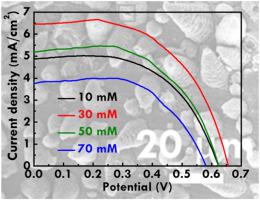Materials Science in Semiconductor Processing ( IF 4.1 ) Pub Date : 2021-08-24 , DOI: 10.1016/j.mssp.2021.106152 Tse-Wen Huang , Lu-Yin Lin , Siao-Ting Hong

|
Fiber-shaped dye-sensitized solar cell (FDSC) is one of efficient energy generation devices for soft electronics, owing to low-cost and dim-light operable features. The key component of FDSC is photoanode, which is responsible for absorbing incident light and generating charges. Designing TiO2 structure is significant for fabricating efficient photoanode of FDSC. In this study, it is the first time to fabricate TiO2 nanoparticle-decorated TiO2 microcone array (TMC) with holes using simple two-step anodization and dip-coating processes as semiconductor on photoanode of FDSC. Different H2SO4 concentrations is used to creating holes on TMC. Holes are generated on TMC in anodization process, but TMC are detached from Ti wire more seriously when higher H2SO4 concentration is used. The optimized photoanode of FDSC is prepared using 30 mM H2SO4. The optimized FDSC shows solar-to-electricity conversion efficiency (η) of 2.52%, while the FDSC with the pure TMC photoanode only shows η of 1.68%. The better photovoltaic performance of FDSC comprising TiO2 nanoparticle-decorated TMC with holes photoanode is owing to abundant contacts between TMC and TiO2 nanoparticles and high surface area of TiO2 nanoparticles for dye adsorption. The highest collection efficiency of 92.21% is also achieved for the FDSC with the optimized photoanode, analyzed using intensity modulated photocurrent/voltage spectroscopy spectra.
中文翻译:

TiO2 纳米粒子在 TiO2 微锥阵列上的装饰,作为纤维状染料敏化太阳能电池的光阳极
纤维状染料敏化太阳能电池(FDSC)具有低成本和微光可操作的特点,是软电子产品的高效能源产生装置之一。FDSC 的关键部件是光阳极,它负责吸收入射光并产生电荷。设计TiO 2结构对于制备高效的FDSC光电阳极具有重要意义。在这项研究中,首次使用简单的两步阳极氧化和浸涂工艺在 FDSC 的光电阳极上制造带有孔的TiO 2纳米颗粒装饰的 TiO 2微锥阵列(TMC)作为半导体。不同的 H 2 SO 4浓度用于在 TMC 上创建孔。在阳极氧化过程中,TMC 上会产生孔洞,但当使用较高的 H 2 SO 4浓度时,TMC 会更严重地从 Ti 丝上脱离。FDSC 的优化光电阳极使用 30 mM H 2 SO 4制备。优化后的 FDSC 显示出 2.52% 的太阳能到电能转换效率 (η),而具有纯 TMC 光阳极的 FDSC 仅显示出 1.68% 的 η。FDSC的更好光伏性能包括的TiO 2纳米颗粒的装饰有孔光电阳极TMC是由于TMC和TiO之间丰富触点2个的TiO纳米颗粒和高表面积2用于染料吸附的纳米颗粒。使用强度调制光电流/电压光谱分析,使用优化的光阳极的 FDSC 也实现了 92.21% 的最高收集效率。



























 京公网安备 11010802027423号
京公网安备 11010802027423号